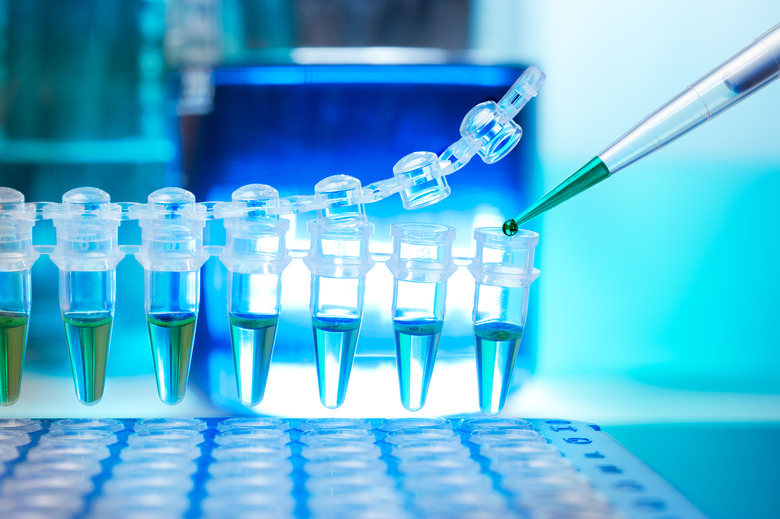How To Calculate The Amount Of Reactant In Excess
The reactant in excess, also known as the excess reagent, is the amount of chemical remaining after a completed reaction. It is governed by the other reactant, which is completely used and can therefore cannot react. When you know the reactant in excess, you can work out the final amounts of both product and reactant.
Things Needed
- Periodic table
- Calculator
1. Balance the Reaction
Balance the chemical reaction to let you assess exactly how much of each reactant is needed. For example, in the reaction Mg(OH)2 + HCl –> MgCl2 + H2O, the starting and finishing materials are out of balance because there is one magnesium atom on each side, but three hydrogen atoms on the left to two atoms on the right, one chlorine atom on the left to two atoms on the right, and two oxygen atoms on the left to one atom on the right. In this example, you add a "2" in front of the hydrochloric acid and a "2" in front of the water to balance the equation. The reaction is now Mg(OH)2 + 2HCl –> MgCl2 + 2H2O.
2. Find Molecular Weight
Convert reactant quantities to moles. Use a periodic table to find the atomic mass units for each element. For example, say you have a solution of 65 grams of magnesium hydroxide and 57 grams of hydrochloric acid. Magnesium has 24.305 atomic mass units, oxygen has 16 atomic mass units and hydrogen has 1 atomic mass unit. You have one magnesium atom, two oxygen atoms and two hydrogen atoms, so work out 24.305 + (16 x 2) + (1 x 2) = 58.305 atomic mass units. This is the weight of a molecule of magnesium hydroxide.
3. Divide Molecular Weight
Use the formula moles = grams ÷ molecular weight. In this example, work out 65 ÷ 58.305 = 1.11. To find moles of hydrochloric acid, work out 57 ÷ 36.45 (because hydrogen has 1 atomic mass unit and chlorine has 35.45 atomic mass units) = 1.56. You have 1.11 moles of magnesium hydroxide and 1.56 moles of hydrochloric acid.
4. Use the Balanced Equation
Apply the mole values to the balanced equation Mg(OH)2 + 2HCl –> MgCl2 + 2H2O. You need two moles of hydrochloric acid to completely react with one mole of magnesium hydroxide, so work out 1.56 ÷ 2 = 0.78. The answer is less than 1.11 (the number of moles of magnesium hydroxide), so the magnesium hydroxide is in excess, and the hydrochloric acid is the limiting reactant.
5. Determine Reactant Percentage
Divide the number of moles of hydrochloric acid that reacted by the number of moles of magnesium hydroxide that reacted. Work out 0.78 ÷ 1.11 = 0.704. This means 70.4 percent of the magnesium hydroxide was used. Multiply the original amount of magnesium hydroxide (65) by 70.4 percent to find the amount of magnesium hydroxide used. Work out 65 x 0.704 = 45.78. Subtract this amount from the original amount. Work out 65 – 45.78 = 19.21. This means 19.21 grams of magnesium hydroxide are in excess of the amount needed to completely react with the hydrochloric acid.
Cite This Article
MLA
Gillespie, Claire. "How To Calculate The Amount Of Reactant In Excess" sciencing.com, https://www.sciencing.com/calculate-amount-reactant-excess-5959682/. 22 May 2018.
APA
Gillespie, Claire. (2018, May 22). How To Calculate The Amount Of Reactant In Excess. sciencing.com. Retrieved from https://www.sciencing.com/calculate-amount-reactant-excess-5959682/
Chicago
Gillespie, Claire. How To Calculate The Amount Of Reactant In Excess last modified August 30, 2022. https://www.sciencing.com/calculate-amount-reactant-excess-5959682/
